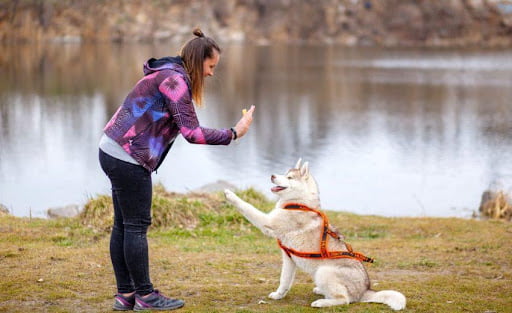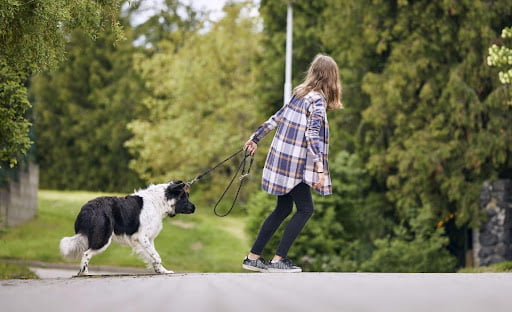Do you ever ponder the thoughts of your dog? Dogs mostly interact nonverbally. Thus, they rely on their body language instead.
Dogs appear to have an intrinsic ability to communicate through body language, or more likely, a collection of advantageous behaviors that have been passed down through the generations and have evolved to reflect what is now our modern dog’s way of communication. Though, it is better to search for “dog behavior therapist near me” to identify body language in dogs.
Communication is key in any relationship, just like it is in this one. However, it turns out that dogs aren’t all that complicated and that reliable communication with them may be achieved quite easily. Thus, a therapist will guide you about the facial expressions, motion, weight, speed, angle, and posture that contribute to dogs’ body language.

You’re Result For “Dog Behavior Therapist” In Regards To Dog Body Language.
Facial Expressions
Dogs communicate with their faces, and you can do the same. You can demonstrate that you are not a threat by maintaining a friendly smile and soft facial features. Thus, a specialist will make you identify your dog’s expressions like – long, joyful eye contact may indicate engagement—getting ready to go for a walk, go swimming, or signal mealtime—in dogs who are really at ease with a person or who are overly friendly with strangers.
If the dog is one you are familiar with and you are feeling intimidated, keep chatting and breathing instead of tensing up. Your tense actions will make the dog even tenser. Make sure you speak with loose lips and a smile on your face.
Reading Suggestion: Disney Getstreaming Tv
As a side note, I do not advise long-term threatening or “show-them-who-is-boss” staring at any dog. If you are successful in being severe, the dog will probably become confused because there is no immediate consequence. Additionally, there are a lot better techniques than intimidation or searching for a “dog behavior therapist” to train your dog!
Moving In One Direction
Dogs can understand a lot about you just by the way you move. When you move toward a dog, it will either slow down, stop or start moving the other way. However, moving away from a dog will cause them to move more quickly, get them moving, or start following you.
Thus, this can be used to communicate with dogs in a variety of contexts. If your dog is too energetic and physical, move swiftly and straight in their direction to stop them before they smash into you. Move away from a shy dog to entice it to approach you if they tend to avoid close proximity.
Therefore, teach children to approach dogs when they generally run away from them to avoid them, especially larger, more boisterous dogs. Since dogs will chase or follow children who run or walk away quickly, this will have the exact opposite impact of what the youngster is attempting to say.
Keeping this in mind, moving away brings dogs closer. This type of dog motion is easy to understand with the help of your search for “dog behavior specialist near me“. However, this will allow you to completely understand the dog’s direction of movement in every aspect.

Body Weight
Your body weight must be taken into account while choosing the direction of movement. When approaching a dog, how far forward are you moving? An extremely enthusiastic dog may need to express more forcefully or intimidatingly.
Therefore, shifting body weight forward may help. Thus, your body weight should be evenly distributed neutral to create a safe first impression, which will be less threatening.
Though, continue with that weight distribution if the dog is timid or spatially aware. Everyone bears their body weight differently, so be sure to modify your actions according to the message you want to convey, especially when combined with the direction of your movement. However, make your understanding better by contacting a “dog behavior therapist”.
Reading Suggestion: Veibae Face Reveal
Speed Of Motion
The pace of your movement conveys to a dog, along with your weight distribution and direction of movement. A dog will be quickly pushed back by a swift movement near them. A dog will move more swiftly and close the gap between you and them if you move quickly away from them.
In relation to the direction you are traveling, a slow motion in either direction will have the opposite impact of a fast motion. In some ways, a “dog behavior therapist” is helpful for you to track “dial-up” or “dial-down” a dog’s movement, depending on your speed.
Position
Your posture can convey a lot to a dog who is more afraid or reactive. Sitting or lying down are the least dangerous poses. However, for the extremely frightened dog, standing can be interpreted as a gesture of intimidation.
Thus, it’s also crucial to remember that when you naturally go from lying down or sitting to standing, a dog could become more agitated. However, to completely acknowledge the feelings or position of your dog, you can search for “dog behavior therapist”.
Takeaway
Facial expressions, movement in a certain direction, positioning, angle in that posture, and voice all combine to create a single instance of communication when you talk to your dog or other canines. Thus, it seems necessary for dog parents to search for a “dog behavior specialist”.
If you want to get some extra guidance on your canine and its behavior, visit the website of Helping Fido. We aid dog owners in forming close relationships with their canines.























